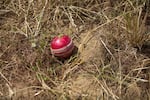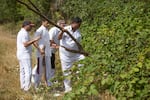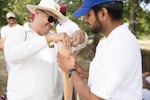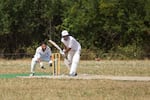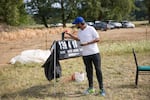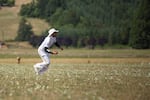
Sumeet Batish bowls to Harjinder Sardar in a cricket match between the Portland Spartans and Multnomah Cricket Club, two of close to a dozen teams that make up the Oregon Cricket League.
Bradley W. Parks / OPB
Sonu Lakhanpal used a fallen tree limb to pull back the thorny blackberry bushes that gobbled up a cricket ball smacked past the boundary.
He leaned into the branch while another player reached into brambles to search.
Losing a ball in the bushes is one of a few minor annoyances for cricketers playing in a farmer's field in Banks, Oregon. But the grounds are big enough for cricket, and that's enough for the players in the Oregon Cricket League.
“When we started, it was actually quite tough to find grounds,” said Paresh Daharwal, a batter for Multnomah Cricket Club.
On a steamy but breezy Saturday in August, Multnomah faced the Portland Spartans on the Spartans’ home grounds: Wingham Farms in Banks. Dressed in their cricket whites for test matches, the teams played before the usual crowd of uninterested cattle and rubbernecking cyclists, runners and walkers on the Banks-Vernonia Trail.
Oregon’s cricket infrastructure is far from robust. But as more people have immigrated to the Beaver State from cricket-loving regions, the Oregon Cricket League has grown. Now, the OCL has four grounds, two tournaments and close to a dozen active clubs.
[video: 081316-cricket-edit-sc,left,57bb6f4167e3e1000fc89a04]
Lokesh Popli plays for the Portland Spartans. He’s a physician who lives in St. Helens. He rolled down the windows of his van and backed into a shady spot before the match against Multnomah. His 5-year-old son was asleep in the backseat.
Few things will keep Popli from playing cricket. He works nights, sometimes even on weekends, but still shows up to play every Saturday and Sunday.
“Sometimes I don’t even get a chance to bat or bowl,” said Popli, a fresh coat of sunscreen on his face. “I’m in my 30s right now, so there are a lot of younger players. It’s just the love for the game that brings us to the game.”
Cricket is baseball’s cousin. It’s played on an oval, typically much bigger than a baseball field. Instead of a pitcher, cricket has a bowler who hurls a ball toward one of two batsmen. Batsmen score runs by running between wickets, which look like small fences. Each team gets a chance to bat. Defending teams must get 10 batsmen out to leave the field; that or deliver 300 balls or 50 overs (an over is a set of six pitches).
Cricket is one of the world's most popular sports: ESPN claimed it has more than five times as many fans as baseball in a promo for the 2015 Cricket World Cup.
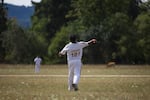
Lokesh Popli flings the ball back into the field. He says few things will keep he and others from playing the sport they grew up loving.
Bradley W. Parks / OPB
The passion is especially feverish in India, from which many OCL players come. The Economist reported an estimated 80 percent of cricket's global revenue is generated in India.
“When we were growing up, we developed a passion for cricket and we love cricket,” Popli said.
Yet the sport has virtually zero popularity — and as a result, infrastructure — in the United States. The shadow cast by sports like football and basketball looms far too large for cricket to catch.
This makes it particularly difficult for new Americans moving from cricket countries to find ways to play. It’s not as easy as, say, a pickup basketball game is at any neighborhood park.
The Oregon Cricket League and others like the Northwest Cricket League, which spans a larger geographic area in Oregon and Washington, provide valued opportunities for cricketers living in the U.S.
“Almost everybody here would probably not know anybody else,” said Harjinder Sardar, who plays for Multnomah Cricket Club. “[Cricket] tends to create this bigger community.”
The OCL was gradually and organically grown.
Multnomah claims to be the “oldest and most established cricket club in Oregon,” but that statement is yet unfounded. Daharwal said the club was started in the mid- to late-80s “by a bunch of English and Australian guys who liked to just drink beer on Saturday and Sunday and just play for fun.” The club is a founding member of the OCL.
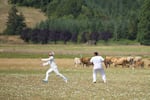
Sumeet Batish chases a fly ball while cattle graze beyond the fence. Players say the cows don't seem to mind the action on the field.
Bradley W. Parks / OPB
Many players in the league seek to deepen Oregon’s connection to cricket, which could in turn connect Oregon to the cricketing communities. Cricketers on occasion hold kids camps to teach people more about the game.
“I know for sure, there are a lot of things around the ‘net that say that, ‘Oh, it’s a boring game,’” Sardar said. “’What do you do? Take a break? Have some tea? Biscuits?’”
Sardar enjoys telling curious passersby about cricket. He thinks if people learn more about the game, they’ll find it more interesting.
“Cricket is probably similar to football in terms of what Americans are used to in terms of the culture around the game and the passion around the game, the fans,” Sardar said.
Whether cricket’s American appeal solidifies because of the Oregon Cricket League’s efforts is to be seen.
But as long as there are grounds, and a bat and ball, cricket in Oregon will continue.
Kashif Humyan said as much sitting on a well-traveled cooler under a shade tree. He drank water from a dusty old milk carton and talked about playing cricket when he was growing up in India.
It didn’t matter if it was on formal grounds, the street or even a farmer’s field, Humyan said: “Wherever we find space, we play cricket.”


